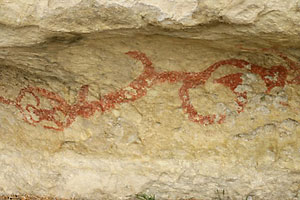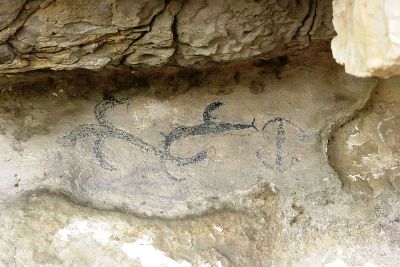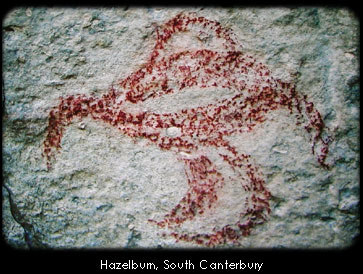Maori Rock Art
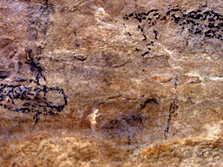 Weka Pass Historic Reserve
(Māori rock art, Weka Pass Historic Reserve)
Weka Pass Historic Reserve
(Māori rock art, Weka Pass Historic Reserve)
Contents
Maori History
The first inhabitants of New Zealand, known today as the Maori, were thought to have come from Eastern Polynesia over 1000 years ago. The Maori first settled on the coasts of the North and South Island and practiced fishing, hunting, and gardening. Over time, the Maori detached themselves from the traditional art style of Eastern Polynesia and developed their own artistic style, easily seen in the creation of their signature carving style and weaponry (Cherry 10-15).
A steady increase in the Maori population eventually led to increased competition and warfare between tribes for land and natural resources. As a result, the Maori built defensive structures known as pas, which can still be seen on the archaeological landscape today. Interaction with foreign European traders and missionaries in New Zealand also led to warfare and a loss of traditional Maori society. Many Maori beliefs and practices were discontinued after their assimilation into European society and warfare over land rights and unfamiliar disease led to a decrease in their population (Cherry 10-15).
Traditional Maori Art
Traditional Maori art was produced using the raw materials found around New Zealand's natural landscape. The Maori used materials such as wood, bone, and shell as the basic canvases for their artistic creations and before their introduction to European metal tools, the Maori constructed their own tools for scraping, carving, and painting. Red, black, and white were the most commonly-used colors in Maori art and often symbolized certain social rankings within Maori society ("Maori Art of New Zealand"). Traditional Maori art incorporated symmetrical curves and spirals as well as figurative images of human ancestors or god-like forms (tiki), bird-like creatures (manaia), merman or sea monsters (marakihau), and lizards (moko) (Barrow 1984: 32).
The Maori had many art forms, including carved wooden canoes and sculpture, personal adornment and clothing, elaborately designed weapons, and rock art (Cherry 10-15). All art produced by the Maori was created for a practical or symbolic reason and often depicted ancestor figures and spirits in a curvilinear style (Barrow 1984: 23-27). Over time, the more symmetrical and simple designs characteristic of traditional Maori art style transformed into a more 'flamboyant' artistic style (Barrow 1978: 71).
Maori Rock Art
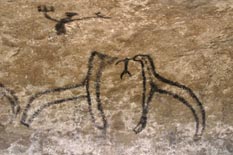 Waikari Rock Art (The Sydney Morning Herald).
Waikari Rock Art (The Sydney Morning Herald).
The majority of Maori rock art can be found in the areas of North Otago and the South Canterbury region. Traditional Maori rock art was either scratched into the surface of the rock or painted using hand-made tools and long-lasting inks [ngaitahu.co.nz|ngaitahu.co.nz]. The images depicted in Maori rock art and their purposes for production are often ambiguous or unknown (Barrow 1978: 44). The carved and painted art often depicted curvilinear designs and figurative scenes of Maori oral tales of myth and legend. Such scenes included, but were not limited to, the story of Maori creation which involved the separation of the Sky Father and the Earth Mother by their children ([newzealand.com|newzealand.com]).
The Maori believed that each man-made work of art had a spirit life (Barrow 1984: 23). They did not think of rock art as an inanimate impractical object; in contrast, the Maori believed that art, and all naturally-occurring objects, had a personality and could gain prestige (mana). The Maori understood the man-made rock art as symbols of the Gods and objects which housed spirits (mauri), ranging from the spirits of a garden to the spirits of a tribe itself (Barrow 1978: 41-44).
Recording Rock Art
Manually tracing rock art is a very effective way to help with the understanding of the engraved surface. Archaeologists also use graphic software, scanning, and auto-tracing to record rock art, making it easier to publish their finds (Arca).
In the 21st century, many archaeologists have turned to the digital recording of rock art because of the subjectivity of traditional techniques of recording. Archaeologists have combined photography and digital image processing to analyze the rock art of Selva Pascuala, Spain. This case involved two stages, the pre-processing stage and the processing stage. The color of the rock and paint as well as the uneven surface of the rock causes archaeologists to perform the pre-processing procedure. Archaeologists first begin by processing the whole image of the rock art, seeking information that is not clearly visible by enhancing the contrasts in color and edges. In addition, the archaeologists also used digital technology to remove the background/surface of the rock so the rock art itself could be viewed without intrusion. Lastly, the archaeologists used the pre-processing techniques of edge detection and zooming up the image to separate the areas of the rock that are painted from those that are not. To achieve the most accurate image of the rock art, the archaeologists combined multiple pre-processing techniques (Clogg, and Diaz-Andreu).
Examples of Maori Rock Art
Takiora, North Otago
The Maori rock art at the site of Takiora was created using many different techniques. Its great use of red pigments and scrolled figure add to this rock shelter's importance ([ngaitahu.co.nz ngaitahu.co.nz]).
Maerewhenue, North Otago
The Maori rock art from Maerewhenue uses liquid paint to depict both naturalistic figures as well as abstract designs (ngaitahu.co.nz).
Waverley Carving
The 'Waverley Carving' occupies a sandstone cliff face in the Kohi Gorge, Waverley District, Wanganui. It incorporates the traditional Maori spiral motif as well as a mysterious lizard (Barrow 1978: 44).
Hazelburn, South Canterbury
The Maori rock art from Hazelburn represents a dog drawn in charcoal on a limestone rock shelter (Barrow 1978: 75).
Preservation and Education
An increased interest in finding and recording Maori rock art has led many archaeologists and organizations, such as The South Island Maori Rock Art Project, or SIMRAP, to survey the South Island for previously-known and new rock art sites. In order to study and educate others about Maori rock art, SIMRAP uses a database and pictorial evidence to document the location and the condition of the rock art (ngaitahu.com).
External Resource
Te Ana Maori Rock Art Centre Timaru [1]
References
Anderson, Atholl 1988 "The Art of Concealment: Some Thoughts on South Island Maori Rock Drawings. in Ka Tuhituhi O Nehera: The Drawings of Ancient Times, National Museum of New Zealand, Wellington..
Arca, Andrea. "Digital auto-tracing in Rock Art Recording Applications of computer vectorial design." TRACCE no. 11 Online Rock Art Bulletin . Cooperativa Archeologica Le Orme dell'Uomo, Web. 22 Feb 2010. <http://www.rupestre.net/tracce/digital.html>.
Barrow, Terence. Illustrated Guide to Maori Art. Honolulu: University of Hawaii Press, 1984. 23-32. Print.
Barrow, Terence. Maori Art of New Zealand. Paris: THE UNESCO PRESS and A.H. & A.W. Reed Ltd, 1978. 42-75. Print.
Blundell, Sally 2010 "Set in Stone" New Zealand Geographic, May/June 2010:74-87.
Cherry, Stella. Te Ao Maori the Maori World. Dublin: National Museum of Ireland, 1990. 10-15. Print.
Clogg, Phil, and Margarita Diaz-Andreu. "Digital Image Processing and the Recording of Rock Art." TRACCE no. 11 Online Rock Art Bulletin . Department of Archaeology University of Durham, Web. 22 Feb 2010. <http://www.rupestre.net/tracce/dip.html>.
"Hazelburn, South Canterbury." Ngai Tahu Maori Rock Art Trust. Web. 23 Feb 2010. <http://www.ngaitahu.co.nz/RockArt/overview.htm>.
"Maori Art." Maori Art of New Zealand. 2006-2010. Maori Tourism Limited, Web. 21 Feb 2010. <http://www.maori.com/maori-art.aspx>.
"Maori Culture." newzealand.com. 1999-2010. New Zealand Tourism Board, Web. 21 Feb 2010. <http://www.newzealand.com/travel/about-nz/culture/culture-maori-culture.cfm>.
"Māori rock art, Weka Pass Historic Reserve." Department of Conservation Te Papa Atawhai. Web. 23 Feb 2010. <http://www.doc.govt.nz/conservation/historic/by-region/canterbury/waimakariri/weka-pass-historic-reserve/>.
"Maori Rock Art." Visit Oamaru. Web. 23 Feb 2010. <http://www.visitoamaru.co.nz/?places&ln=duntroon>.
"Ngai Tahu Maori Rock Art Trust." ngaitahu.co.nz. 2009. Ngai Tahu Maori Rock Art Trust, Web. 21 Feb 2010. <http://www.ngaitahu.co.nz/RockArt/profile.htm>.
smh.com.au The Sydney Morning Herald. Web. 23 Feb 2010. <http://blogs.smh.com.au/trampaboutnz/archives//013822.html>.
Waymarking.com. Web. 23 Feb 2010. <http://www.waymarking.com/waymarks/WM7QKP_Maerewhenua_Maori_Rock_Art_Duntroon_New_Zealand>.
